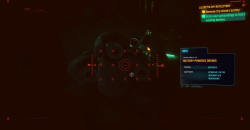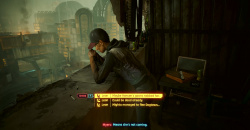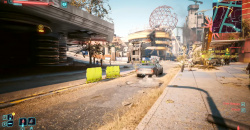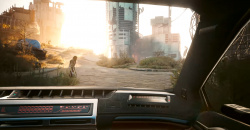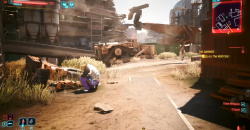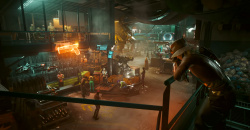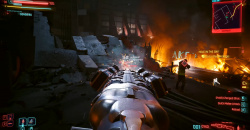
On September 26, the long-awaited expansion to the cyber-action role-playing game from developer and publisher CD Projekt RED was finally released. In my review, I would like to tell you what awaits V.
Political fronts expected
Phantom Liberty has radically changed the tone of the narrative, moving from the introspective narrative arc of V to a more expansive storyline that incorporates the various political fronts that define the rules of the world of Cyberpunk 2077, government intrigue of all kinds, and a heavy influence on the cinematic spy stories that were so fashionable in the 70s and 80s. The paradigm shift is sharp and in some ways downright disorienting. Dogtown, the new district available in Phantom Liberty, strongly shifts the direction of the graphic design towards a military-futuristic style that is much more homogeneous in the overall vision of the work than it seemed in the previews shown by CD Projekt RED in recent weeks.

Missions and optional assignments
Phantom Liberty includes about thirty new missions, divided into main and side ones, that will keep you busy for about twenty hours before you complete them all - just scratching the surface of this expansion. Phantom Liberty offers two different endings, which not only differ in the last mission available, but also take shape in the moment in which an important decision must be made, capable of changing the upcoming missions, as well as everything that will revolve around V in terms of sidekicks and lineups. If that alone isn't enough to make this expansion so interesting, you should know that all the decisions you make in Phantom Liberty will form a new epilogue for the base game, which will take into account all the new plot elements introduced with this expansion. This expansion reflects the best of CD Projekt RED, namely the attention to detail that offers a narrative that is consistent with what it was and that is able to provide more than justified motivations to replay the work as a whole to understand how much the arrival of a new part of the plot actively affects the entire game world. If I want to criticize Phantom Liberty, I can say that it won't blow the minds of those who prefer a stealth approach. The missions all seemed to me to perfectly fit the presented themes, even if this means that they often impose a more aggressive and "trigger-happy" style on the player, as opposed to the more elegant and calm methods.
Finally the cyberpunk we were promised
It's impossible to imagine Phantom Liberty without the 2.0 update, and the reasons for this are all due to how much this expansion pushes the new gameplay mechanics introduced by CD Projekt RED. Vehicle-based combat, rethought law enforcement, improved enemy intelligence and the reworking of V's skill management are all elements that allow Phantom Liberty to make the activities offered varied and rewarding in terms of difficulty. The addition of 10 levels (the ceiling increases from 50 to 60), the new branch of talents and the new management of stats and cyberware allow Phantom Liberty to fit into Cyberpunk 2077 without upsetting the game balance, making the game experience more homogeneous and offering far fewer glimmers of "total game breaks". It's still possible to turn V into a superhuman capable of overcoming any obstacle that comes his way, but it's much less easy now and provides the right balance that hasn't been a perfect focus in Cyberpunk 2077 until now. As for the additional activities, apart from the expansion's missions, there are also vehicle theft (optional missions available throughout Night City) and air supply (exclusively available in Dogtown and allows you to get very rare loot by finding the landing point of those tank crates). It should be emphasized that, despite all the revisions to the skills, a better balancing of the experience and, of course, the new activities added by Phantom Liberty, this expansion doesn't distort the final experience that Cyberpunk 2077 offers, but improves it in every way, making Night City more alive and giving the player more freedom to explore.

Much more possible
Dogtown is a neighborhood that is easily comparable in size to the neighborhoods already present in the base game. The only real difference that nobody can deny is the greater density of things you can do in this district, and this isn't surprising compared to the rest of the experience. As for the setting, everything is perfectly merged with the rest, and the change in graphic representation is barely noticeable, making the more militarized areas a distinctive feature of the district, which is quite comparable to the other areas of Night City. However, in Dogtown there are many more rooms with visitable interiors, much larger areas in which to move around with vehicles (clearly designed for vehicular combat), and a level design based on a much more thought-out architecture that is the result of the experience gained over the last three years. This isn't to say that Night City has become "ugly", but it's obvious that, the original layouts of the city didn't work perfectly around some of the new game mechanics.Graphics and sound:
The new polygonal models of the protagonists are incredible and show in an even more obvious way the technical distance between them and the passers-by roaming the streets of Night City. Dogtown is a celebration of colorful lights, which is best appreciated when you sit on a rooftop and watch the neon lights and signs merge into a breathtaking sight. Finally, we can't fault the soundtrack (just as rousing as that of the original game and the Edgerunners anime) and the excellent Italian as well as German and English dubbing, which once again reminds us what it means to work in a polished and cozy way in this area as well.









